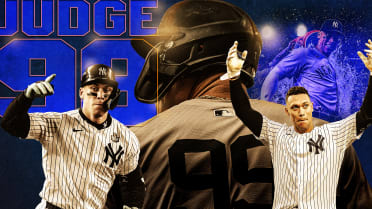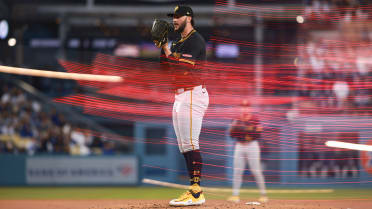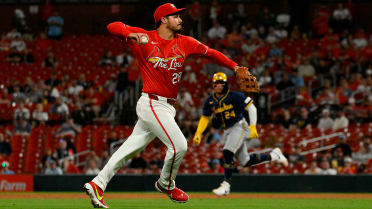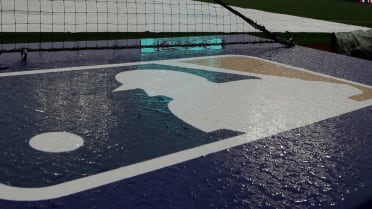If you were asked who baseball's most effective reliever is right now, you might go to the strikeout kings of the moment -- Josh Hader and Adam Ottavino -- who have combined to fan 54 percent of the hitters they've faced. Maybe you'd say Craig Kimbrel, Albertin Chapman or (before his recent struggles) Kenley Jansen -- the "big three" closers for the past half-decade. Perhaps you'd think about the more recent breed of non-closer, multiple-inning types like Andrew Miller or Chad Green.
All are solid choices. We're not going to go with any of them. Allow us instead to make a case for Washington's Sean Doolittle, who combines lack of contact and poor contact in a way no other pitcher does.
Seriously. Statcast™ has a fancy metric called "Expected Weighted On-Base Average" that's a lot simpler than its name may imply. It looks at real-world strikeouts and walks, along with the quality of contact based on exit velocity and launch angle, and it outputs a number that's similar to OBP, except with extra-base hits given more value. Last year, the league-average mark was .321. Aaron Judge led hitters with a massive .443. Max Scherzer led qualified starters with a tiny .246 mark against.
So far this year, 336 pitchers have faced at least 50 batters. Look who's number one -- just ahead of Hader.
2018 Expected wOBA leaders, minimum 50 batters faced
.171 -- Sean Doolittle, Nationals
.186 -- Josh Hader, Brewers
.198 -- Jose Alvarado, Rays
.205 -- Aroldis Chapman, Yankees
.207 -- Dan Winkler, Braves
(MLB average: .333)
OK, it's only been a few weeks. Alvarado and Winkler aren't exactly household names, though there's Chapman again in the top five. (Where's Ottavino? He was in the top three, but a poor outing on Tuesday night, including a Justin Upton homer, pushed him to seventh.)
What if we look at the past two seasons together, now comprising 393 pitchers who have faced at least 200 batters. Look who is still No. 1.
2017-18 Expected wOBA leaders, minimum 100 batters faced
.211 -- Sean Doolittle, Nationals
.222 -- Pat Neshek, Phillies/Rockies
.232 -- Josh Hader, Brewers
.236 -- Kenley Jansen, Dodgers
.238 -- Aroldis Chapman, Yankees
.238 -- Andrew Miller, Indians
.238 -- Jose Alvarado, Rays
.241 -- Craig Kimbrel, Red Sox
(MLB average: .323)
That's Doolittle atop this year's list, and atop the list beginning from the start of last year, ahead of some extremely impressive names -- exactly the names you'd expect.
If we look at 2016-18, setting a minimum of 300 hitters, Doolittle's .236 Expected wOBA is fifth of 459 hurlers, behind Jansen, Miller, Chapman and Neshek. (Neshek is really good, for the record.)
Going back to 2015-18, with a minimum of 400 hitters faced, Doolittle's .239 is again fifth, now of 483 pitchers, behind Jansen, Miller, Zach Britton and Chapman.
If we go all the way back to Doolittle's debut in 2012 -- and this is pre-Statcast™, so we're just looking at actual wOBA outcomes here -- his .242 is seventh best of 424 pitchers with 100 innings pitched. He's so, so, good, and has been for years. That sets Doolittle apart from Ottavino, who had a terrible 2017, and Hader, who hadn't yet made his Major League debut at this time last year.
You probably know the Doolittle story, but in case you don't: Drafted as a first baseman by the A's in 2007, he struggled to overcome injuries as a Minor League hitter, eventually converting to the mound in '11. Doolittle reached the Majors in '12, was an All-Star in '14 and generally has been dominant (when healthy) ever since, around being traded to the Nationals last summer.
Doolittle does almost literally one thing: throw high fastballs. Since the start of 2017, only one pitcher (Colorado's Jake McGee) has thrown a higher rate of four-seamers than Doolittle's 87.2 percent. On those four-seamers, only two regular relievers has thrown them higher off the ground when they reach the plate than Doolittle's 3.05 feet. This has been true basically since the first day he arrived in the Majors. As Doolittle told MLB.com's Matt Kelly recently, his high-flying style of pitching has situated him well for the "launch-angle revolution."
Maybe that's helped, but again, this isn't new. Doolittle has been perhaps the best reliever this year, and across the past two years, and very good for more than a half-decade.
How is this so, exactly, considering the great names out there? This is an oversimplification to some degree, but pitchers basically have three important jobs: get strikeouts, prevent walks and limit hard contact. Here's how Doolittle does in all three of those categories, which all go into his wOBA number.
He's elite at missing bats
Doolittle isn't exactly Hader when it comes to whiffs, but he's still one of the best in the game. Entering play on Wednesday, his 44 percent strikeout rate was the sixth best of 197 qualified relievers. Combine 2017 and '18, and Doolittle is in the Top 15 of any reliever with 60 innings. Going back again to '12 and those 424 pitchers with 100 innings, his 30.7 percent strikeout rate is tied for 15th. (With teammate Scherzer ... who's done it as a starter. Scherzer is a legend.)
If not Hader or peak Chapman, Doolittle's 98th-percentile rate is about the best you can do.
He limits walks, too
This is somewhat less interesting than the category before or after it, so we'll do this one quickly:
Doolittle is one of the best at avoiding walks, too. His 5.2 percent walk rate is one of the dozen-best marks of the 149 relievers with 60 innings over the past two years. Dial up our "since 2012" leaderboard again, and his 5.0 percent walk rate is tied for 18th best.
This is 90th percentile, or slightly above. Again, this is elite level.
He simply does not allow strong contact
Missing bats and preventing hard contact often goes hand-in-hand, but not always. Kimbrel, for example, led the Majors in strikeout rate in 2017, but he also allowed the highest average exit velocity of any of the 438 pitchers with 100 balls in play, at 91.3 mph -- and the second-hardest hard-hit rate, at 44.6 percent. It wasn't easy to make contact, yet if you did, it could be good contact.
Doolittle is the exact opposite, if you look at our leaderboards. So far this year, 381 pitchers have allowed 25 batted balls, and you won't be surprised to see that Doolittle has allowed the lowest hard-hit rate (14.8 percent), which we define as "batted balls of 95 mph of exit velocity or more." Doolittle has allowed only four hard-hit balls this year (Hader and Ottavino have allowed eight apiece.)
2018 Lowest Hard-hit Rate, minimum 25 balls in play
14.8 percent -- Sean Doolittle, Nationals
16.2 percent -- Walker Buehler, Dodgers
17.6 percent -- Paul Sewald, Mets
18.9 percent -- Chaz Roe, Rays
19.1 percent -- Tyler Clippard, Blue Jays
(MLB average: .36.7 percent)
Consider, for context, that Chris Tillmanallowed six hard-hit ballsin the first inning against the Angels on Friday.
For Doolittle, it's the same for the past two seasons, too. He is atop that list as well. We'll call him 99th percentile in preventing hard contact.
In addition to preventing hard contact, Doolittle is inducing plenty of contact in bad directions, too. In 2017-18, we've seen 473 pitchers allow at least 100 batted balls. He has forced hitters to hit popups on 22.4 percent of the contact they make -- again, the best in baseball. Popups are basically strikeouts, anyway; the Majors hit .022 on them in '17-18, and most of the "hits" were fielding mistakes that probably should have been considered errors.
Doolittle is also making it happen more often so far. In 2016, he got popups 13 percent of the time. Last year, it was 21 percent. Now, it's 30 percent. These are basically free strikeouts that require only one pitch.
We'll call Doolittle 99th percentile in forcing the worst kind of contact a hitter can make.
You see where this is going, right? Doolittle is elite in getting strikeouts. He's elite in limiting walks. Doolittle is arguably the best in the entire game at limiting hard contact and inducing poor contact. Sure, Hader and Ottavino may be more stunningly dominant this year, in part because they've somewhat come from out of nowhere. Is it possible that because Doolittle has been doing this for years, with one pitch, with the same strategy, that he's almost "boring"?
Maybe so. Either way, the Nationals will take it. Doolittle may not be the first name you think of when you think of baseball's best relievers, but he should be. He's got the credentials to back it up.
Mike Petriello is an analyst for MLB.com and the host of the Statcast podcast.



